Common Houseplant Pests: Identify and Eliminate These Nuisances
If you have recently spotted insects on your houseplant, you might have a pest problem. Several pests can invade your houseplant and affect its health. Sometimes you can even carry pests into your house unknowingly after purchasing a new houseplant. Identifying common houseplant pests early is the key to saving your plant. Keep reading to discover more about houseplant pests.
Common houseplant pests
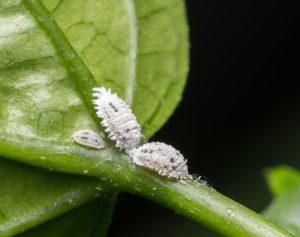
Most houseplants are prone to pest infestations. Below are some common houseplant pests with pictures that can invade your plant.
Mealybugs
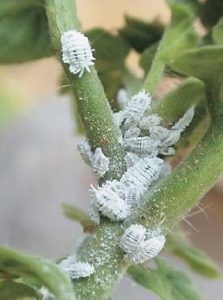
Mealybugs are small pale white insects that appear fluffy. These insects are among the most common houseplant pests that can attack your plant. Mealybugs are related to scales and suck the sap out of your houseplant making it weak.
Mealybugs secrete a sticky substance that they use to protect themselves from being sprayed off. This sticky substance is called honeydew and it promotes the growth of sooty mold. When left uncontrolled, sooty mold can block your plant’s leaves from absorbing enough lighting.
How to spot mealybugs
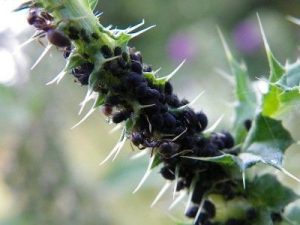
You can spot mealybugs on your houseplant by closely inspecting your plant. If you see sticky spots on the leaves of your plant, you might have a mealybug infestation. A black sooty substance might also indicate the presence of this common pest on your houseplant.
How to control mealybugs
You can get rid of mealybugs from your houseplant by cutting off the affected parts. For light infestations you can use a cotton swab dipped in alcohol to wipe off the mealybugs from your plant. Washing your houseplant with water can also get rid of these insects. You can also apply insecticidal soap or neem oil to remove mealybugs from your houseplant.
Spider mites
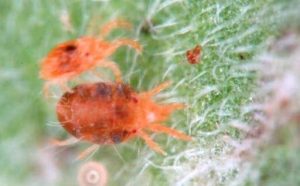
Spider mites are common indoor houseplant pests that can attack your plants. These insects are tiny and look like black flecks on your plant’s leaves. Spider mites suck the sap from your houseplant leaving pale spots on the leaves. These common houseplant pests cause leaves to drop and weaken your plant gradually.
How to spot spider mites
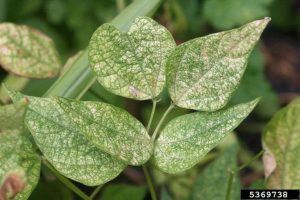
Spider mites can be difficult to spot due to their small size. However, these pests cause yellow or brown spots on the leaves. Spider mites also create webs on the undersides of your plant’s leaves.
How to control spider mites
Spider mites can spread easily from one plant to the next. The pests are also very tiny which makes it very difficult to spot them early. However, you can still save your plant by spraying it forcefully with a stream of water. You can also use insecticidal soaps and oils to get rid of these pests. Insecticides can also be effective against spider mites.
Aphids
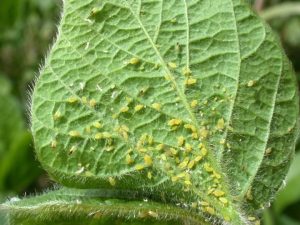
Aphids are common houseplant pests that attack indoor plants. These insects are small and cluster on the leaves of your plant. Aphids can be green, yellow, black, or brown. These sap-sucking insects are fond of sucking sap from new growth.
Aphids damage your plant’s leaves and cause stunted growth. These pests secrete honeydew that might cause sooty mold to develop.
How to spot aphids
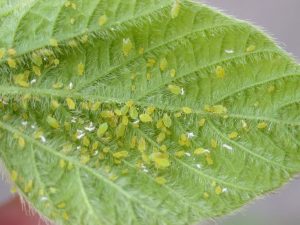
Aphids are visible on the leaves of your plant in clusters. You can spot these insects on the undersides of your plant’s leaves. These insects also cause wrinkly leaves and leave sticky residues on the undersides of your plant’s leaves.
How to control aphids
You can effectively get rid of aphids if you detect the infestation early. You might not save your plant when the infestation becomes severe. For mild infestations, you can get rid of aphids by wiping them with a cotton ball dipped in alcohol. You can also spray your plant with insecticidal oil or soap. If the aphids persist, you can apply pesticides to your plant.
Fungus Gnats
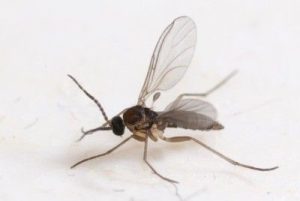
Fungus Gnats are tiny insects that resemble flies or mosquitoes. You can find these common houseplants in the soil. Adult fungus gnats don’t feed on your plant but they can be annoying.
However, immature fungus gnats larvae feed on your plant’s roots causing damage to young plants. You are more likely to spot these insects when you have an overwatering problem.
How to spot fungus gnats
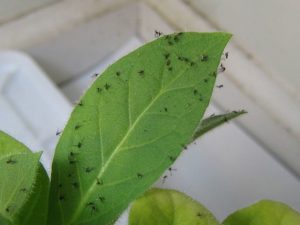
You can spot adult fungus gnats hovering around your plant’s soil. Your plant might also start wilting and developing yellow leaves due to damaged leaves. If you notice signs of poor growth, you should examine your plant closely for fungus gnats.
How to control fungus gnats
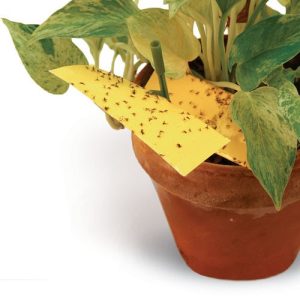
Fungus gnats thrive in damp soil. Drying out the soil can eliminate larvae and deter adult gnats from hovering around your plant. You can also use fly traps to get rid of the mature adult gnats. Treating the soil with neem oil or a product with Bacillus thuringiensis can eliminate the insects.
Scales
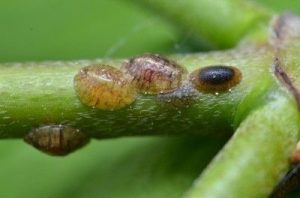
Scales are common houseplant pests that can invade your plants. These tiny houseplants have a waxy coating that they use to protect themselves. These waxy coverings are brown and resemble small bugs.
You can spot scales on the undersides of leaves and stems. These insects mostly invade Ivy plants and figs. Scales suck the sap from your plant’s leaves causing them to dry out and wilt. These insects also secrete honeydew that causes sooty mold to grow on your plant.
How to spot scales
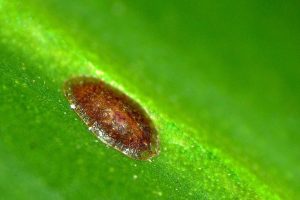
Scales often secrete a sticky sap that you can spot on the leaves and stems of your plant. You can also spot the brown bug-like spots on your plant.
How to control scales
Scales build a protective layer which makes it difficult to eliminate the pests with chemical solutions or pesticides. You can manually scrape off the scales using your hand or wipe them off with a cloth dipped in alcohol. Removing the affected parts and spraying your plant with insecticidal soaps and oils can also do the trick.
Whiteflies
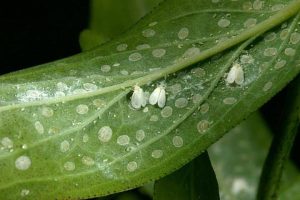
Whiteflies are common houseplant pests in white that might attack your plant. These insects are white and look like tiny moths. Whiteflies are flying insects that feed on your houseplant by sucking its sap.
However, immature larvae don’t move. Both immature and adult whiteflies cause damage to your plant causing stunted growth and discolored leaves that eventually drop off from your plant.
How to spot whiteflies
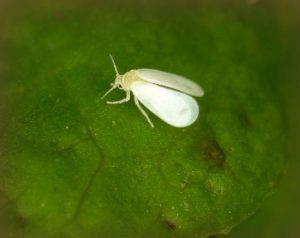
You can identify whiteflies easily by examining your plant. These winged insects have powdery white bodies and you can find them on the surface or undersides of your plant’s leaves. Whiteflies also cause leaf discolorations and secrete honeydew.
How to control whiteflies
To get rid of whiteflies, spray your plant forcefully with water. You can also apply insecticidal soaps or oils to your houseplants to eliminate these pests. For more severe infestations, you can use pesticides.
Common houseplant pests: How to prevent common houseplant pests
After getting rid of common houseplant pests, you can take precautionary measures to avoid future problems. Below is what you should do to prevent pest infestations.
Check houseplants for pests before bringing them indoors
When you purchase new houseplants, thoroughly inspect them for common indoor houseplant pests. Check the undersides of the leaves and stems for any pests or signs such as waxy excrement. Once you are sure that your houseplant doesn’t have any pests, you can bring it indoors.
Isolate new houseplants from old houseplants
Avoid mixing up your new houseplants with the old ones for some time until you are sure they are pest-free. In case of any pests, you should address the problem before mixing the new houseplants with the old ones.
Use clean pots and fresh soil to pot your houseplants
Always sterilize your containers before potting your plant. Also, ensure your potting soil is pest-free. You can purchase a houseplant potting mix from a reliable brand online.
Constantly check your plant for pests
Occasionally examine your houseplants to check for pests. Identifying a pest infestation early can help you stop the pests from spreading and avoid future problems.
Use clean gardening tools to tend to your plants
Always clean your gardening tools before and after tending to your houseplants. Cleaning your tools prevents you from spreading any pests to your healthy houseplants.
Regularly remove dead leaves and branches from your plant
Dead leaves and branches can attract pests to your houseplants. To prevent this, regularly get rid of damaged plant parts. Ensure you provide the right growing conditions to prevent plant damage in the first place.
Regularly clean your plants
Try to clean your plants regularly with a damp cloth to keep them free from pests. Cleaning your plant also keeps it looking great.
Common houseplant pests like whiteflies, spider mites, mealybugs, or fungus gnats can attack your houseplant and weaken it. Spotting houseplant pests early can help you easily eliminate them. You can avoid future pest infestations by constantly examining your houseplants after purchasing them. Isolating new houseplants prevents the pests from spreading. If you require more assistance with houseplant pests, get in touch with us today.
